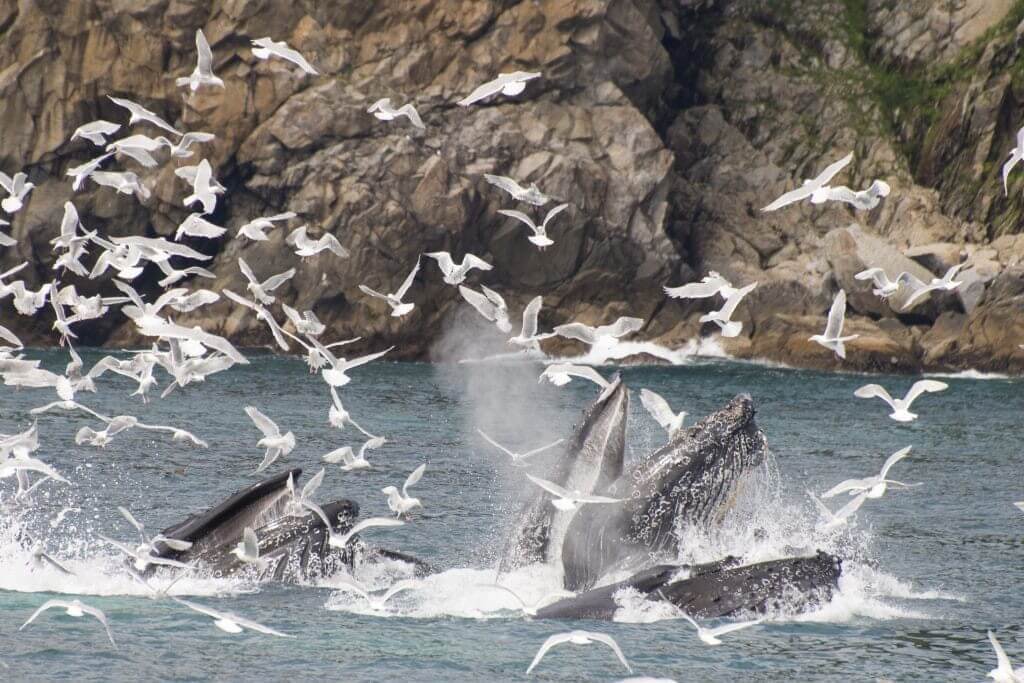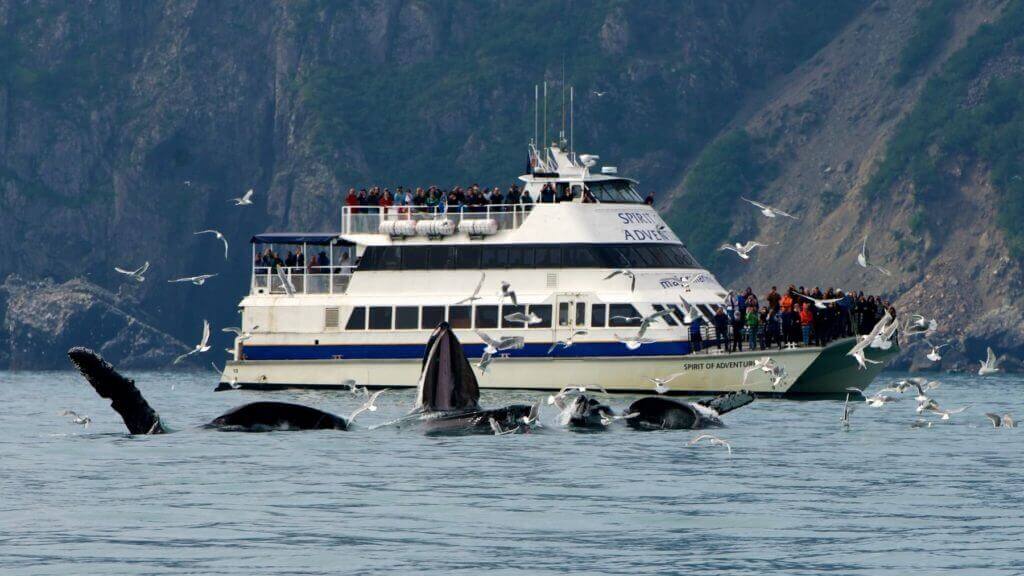Bubble net feeding is a spectacular sight to behold. This incredible behavior, exhibited by humpback whales, occurs every summer in the waters of Resurrection Bay and Kenai Fjords National Park for a short time. Usually starting in June or July, this behavior can last for several weeks or sometimes just a few days. This year, bubble net feeding started up on June 6th and then again on June 13th. In honor of the return of this fascinating cooperative humpback behavior, read our Deckhand Diary about the return of bubble net feeding to the waters outside of Seward a few seasons back.
The world of a humpback whale moves with a motion so foreign that they may as well be swimming through outer space. Schools of sand lance or capelin cloud in whirlpools of silver bodies. With pectoral fins as graceful as wings, the humpback soars through the thick green of life. Their bodies curve around the silver clouds with a grace we will never see. They are the ballerina whales, hidden behind the curtain of the sea, dancing a life our land-heavy minds can never fully understand.
And then, for a few weeks each year, they erupt from that curtain in the mind-numbing frenzy of bubble net feeding.
With bubble net feeding, the secret world of feeding humpbacks explodes onto the surface. From the bow of a Major Marine Tours boat, we watch as the ventral pleats of the humpback’s throat balloon outwards, framing the narrow plate of rostrum that triangulates their baleen and mounded blowhole. Barnacles cling to waterfalled skin. Then the whales sink back down, drowning their secrets, allowing us to say that we have just witnessed the closest thing to alien life.

Bubble net feeding occurs when a group of humpbacks, solitary animals without the fixed family pods of toothed whales such as orca, come together for a common goal: food. As the longest day of the year nears, and summer enters its full Alaskan glory, schools of fish spin in vast underwater clouds and the humpbacks arrive from their long Hawaiian migration to refill their stores of body fat. They surge through schools of fish or krill, mouths open and throats ballooning, gulping ton after ton of small animals as they use their massive tongue to expel excess water out of their sieve-like baleen. Yet while a solitary humpback whale swims surrounded by food, it takes energy to corral those fish into bite-sized chunks.
Enter bubble net feeding. After years of feeding in Alaska, and primarily in Southeast Alaska, humpback whales have learned that there is convenience in numbers. Bubble net feeding emerges as a cooperative effort, in which each whale has a role, and each whale benefits. One individual swims in a circle below a school of fish, blowing bubbles which rise up through the water column to trap fish in a tube-like “net” of air. The other whales swim below, waiting, until the most experienced of them announces with a loud trumpeting call that the time has come. Together they surge toward the surface, mouths agape, throats extended, catapulting from the water’s edge with water streaming from their baleen.

I saw bubble net feeding for the first time this year from the bow of the Orca Song, my hands holding a hydrophone over the railing, my ears filtering out the distant squeaks of orca to listen for that blast from the trumpeter. The surface of the water was still and silent, winged clouds of kittiwakes mirroring the schools of fish below. Everyone on board waited, oblivious of the underwater dance taking place somewhere beneath our feet. We had seen six whales go down, their flukes lifting, but we had no idea where they would pop up and only a faint idea of what they were doing in the world beneath us. Kittiwakes cast their eyes wide, roaming. Then a cry, and our eyes all turned in line with the birds that dropped as one from the sky, as at the center of all of these lines of sight six whales burst from the surface of the water. I saw the mountain peaks of their pointed jawlines, like a new island born that moment from the sea. I saw the grooves in their throats, extended, rippling. And I saw them sink down again, into the world that only they knew.
The next day we came back. The whales were still there. I stood in the wheelhouse with Captain Sarah as the whales dove at a distance, six tall blows, six wide flukes. A juvenile surfaced in the distance, still too young and awkward to join the grown-up table. We searched in all directions, not knowing where the whales would surface, our breaths collectively held. Then, a jagged lunge, wide and silent, close to the boat by the whale’s own choice. For a second there was that thick moment, without weight and without time, when the whales hovered at the peak of their lunge. I watched the jagged line of mouths agape. I saw the way water fell from their baleen. I noticed barnacles folded into one whales ventral pleats. And I held onto that moment, folded it into my own memory, naming that as image I would keep of these animals throughout the summer: Powerful. Vast. Alien.
“That’s Crazy Tail,” Captain Sarah said excitedly, pointing to a whale with a lopped-off right fluke. “He’s the one that came from Southeast Alaska and taught the rest to bubble feed.” And the world I glimpsed widened by that small space.

I know that bubble feeding will not last forever. I know that these animals will follow the most efficient route to feeding, and that sometimes that will mean swimming alone. Sometimes it will involve tail lobbing, lunge-feeding, maybe even a breach. Sometimes it will be simply columns of air hinting at the life below. But for now, I look forward to every day on a Major Marine Tours vessel, because every day brings the chance for that glimpse of timeless power. Every day, an unknown sea might unfold and show us its dancers. Every day is a chance to see the awesome beauty of the humpback whale. And every day I will be looking.
And, from the bow of a vessel on a Major Marine Tours cruise, you should watch as well.
Tamara Lang is a captain with Major Marine Tours in Seward. She is a writer of creative nonfiction and the author of “Upstream: A Written and Photographic Journey up the Los Angeles River.” Her writing and her travels can both can be followed on facebook at Tamara Lang Writes, or at tamaralang.com.
Signup for our newsletter to get the most recent Major Marine updates.